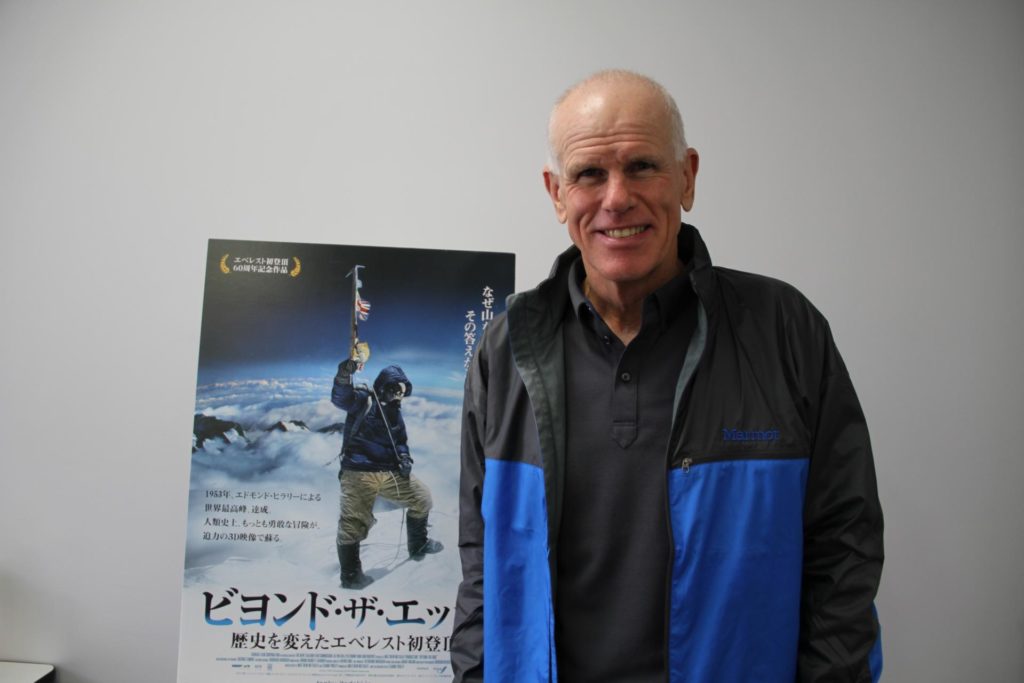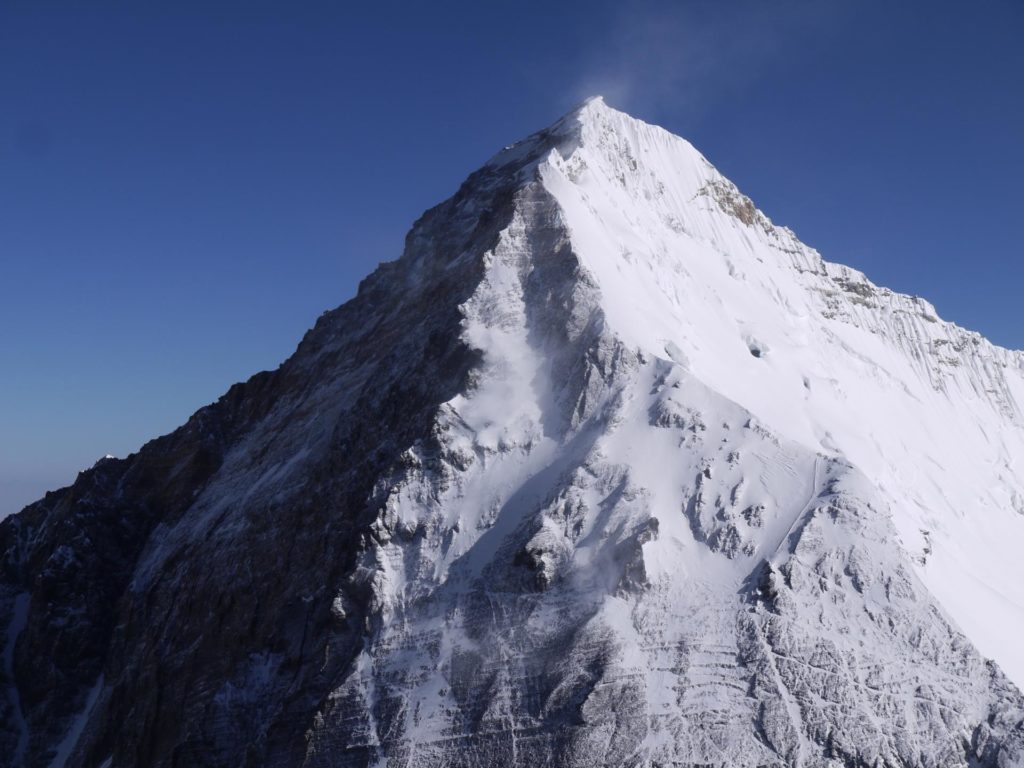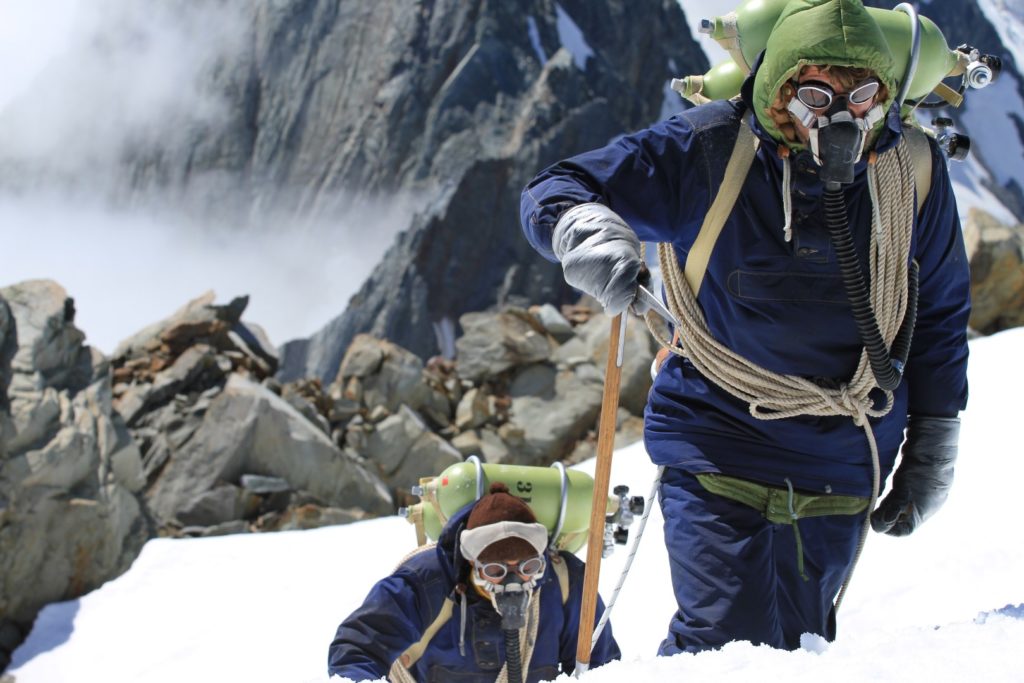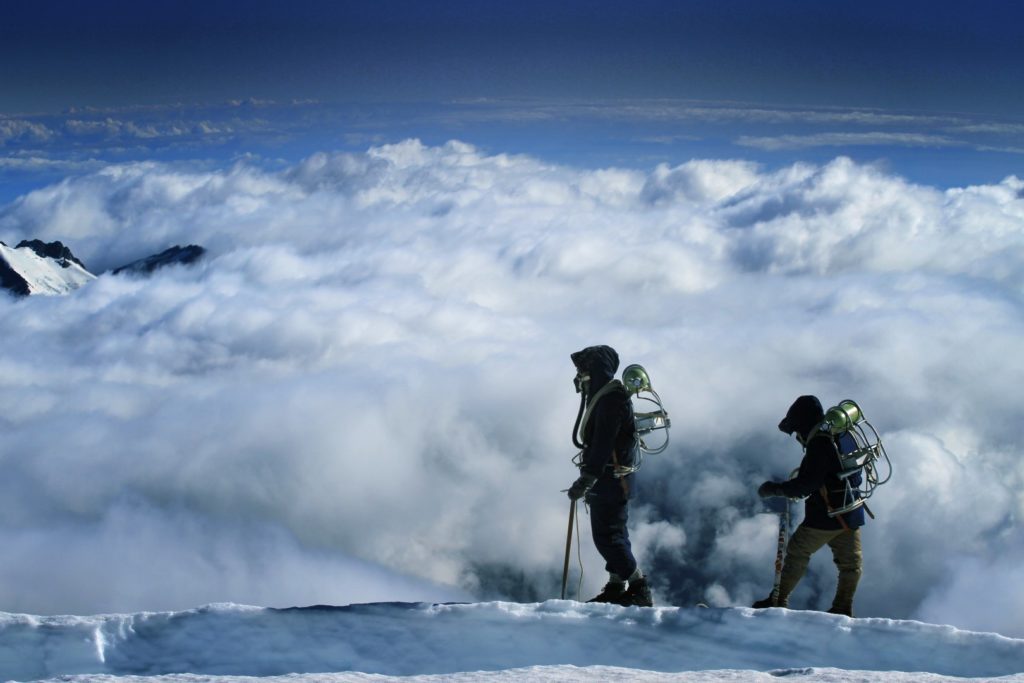In 1953, Sir Edmund Hillary made the first ascent of Mt. Everest with his climbing partner Tenzing Norgay. The names Everest and Hillary have been linked ever since. Sir Edmund’s son Peter, an accomplished alpinist in his own right, has carried on the legacy of adventure for the first family of mountaineering. He and his wife Yvonne sat down with Outdoor Japan contributor Tracy Lenard to talk life, adventure and the release of “Beyond the Edge,” a new film Peter helped produce about his father’s life.

Welcome to Japan. Have you been here before?
Peter: Only once, about 20 years ago on a business trip, mostly in Tokyo, but we briefly went out to some mountains nearby.
Yvonne lived here for nearly four years, so we caught up with some of her friends this trip, which was really lovely. But I have been hankering to take the kids up to Hokkaido. We like skiing, and everyone tells me Hokkaido is a skier’s paradise. Is the powder as good as they say?
Better. I’m a powder addict myself and, when friends come to visit, they can’t believe it.
P: Well, I think we’ve recruited “madam” here, since she enjoyed being reunited with her friends so much. Now everything is in place.
I had a chance to see the film last night and, I have to say, I was incredibly impressed.
P: You saw the 2D version?
Yes. It was a beautiful film. Other mountaineering films are usually not nearly as well produced. How much were you involved?
P: I was somewhat involved in the whole thing, and it’s been a fascinating journey. I helped with narration and advised on the mountaineering, how to get the re-enactments done and who to contact to film those particular sequences.
P: I remember the director, Leanne Pooley, called me up and said, “I found the guy to play your father, but I want you to come and look at the photographs.” She looked really nervous as she brought out the photographs. They were mocked up, wearing all the gear, and I just went, “I can’t believe it!”
Chad (Moffitt) is incredible.
P: Absolutely.
Spitting image.
P: Yeah, so I said, “The only problem is he is going to redefine what Ed Hillary looked like.” You know, they did a great job, and they had a lot of support from the production team that worked on “Lord of the Rings” and “The Hobbit.” It was pretty marvelous, that stuff.
I learned a lot about your father and Tenzing watching the film. A lot of the portrayals I’ve seen before really focused on Ed, and him leading everything. I never really understood that Tenzing was such a passionate climber. The film really brings that home. I think that’s one of the most interesting things. I remember there was a quote your dad said on the soundtrack, “John Hunt didn’t really want two Kiwis standing on top of the mountain,” and he thought, “I need to look around for a climbing partner.” He had the whole expedition search for a partner and discovered Tenzing was the best to go for it.
P: I think it says a lot about John Hunt actually. But also, you must bear in mind that the dozen or so British climbers who were there already had their attempts. (Tom) Bourdillon, (Charles) Evans and the others. On these sorts of expeditions, you find about half the people performing OK, but it’s like they can’t really get it together physiologically; things aren’t working. So, in fact, there may have only been two other real strong contenders. Then people like Alfred Gregory, George Lowe and John Hunt himself put so much effort into the support. So, while they also could have had summit potential, they were exhausted.
It’s not uncommon for people who have climbed Everest to ask each other, “How long did it take you to feel you’d regained the spring in your step? A couple of months?” I mean it really knocks you around. You feel like a flat-footed policeman for the first couple of months when you are jogging, and then all of a sudden you go, “I’m rolling up on the balls of my feet, I’m getting that going again.” It’s like the energy is drained out of you. It affects you a lot.
That brotherhood of the rope Ed and Tenzing shared, it really seems to have worked out well and brought them together. It seems like they shared a lot past the summit.
P: Yes, we saw quite a lot of Tenzing, but also his family. For me personally, my involvement with the Tenzing families has been a fantastic thing. I have e-mail or telephone contact with them every couple of weeks; Norbu and Jamling in particular. Jamling and I have guided some clients together and we were on the Everest expedition together in 2002, so we do quite a few business things together. Norbu is the Director of Funding of the American Himalayan Foundation, and I’m on their board, so we are in touch about that too quite a bit. In fact, I’m working with him in 10 days time, associated with some fund raising I’ve been doing.
Does that have anything to do with the accident on Everest in April?
P: Well, all of us are putting a whole lot of resources into what happened up there.
A real tragedy.
P: A terrible tragedy. In fact, I don’t know what you know about climbing on Everest, but if you look at the history, people have been dying in the icefall; it’s just like that, and the challenge here is if something different doesn’t happen, history will just be pushed out into the future. It is a numbers game.
Personally, I’m not against the guiding. I think it is great people are getting out and challenging themselves. But what worries me is the high altitude porters who just go up and down every day, because their vulnerability is immense.
Indeed. Over the years as the commercial interest has become more prevalent on Everest, have you noticed there’s been any sort of tension building up? Tenzing said, “I’m a climber. I’m not just a pack mule.” It seems like more of the Sherpas are becoming skilled climbers and guides.
P: That’s true. A lot of them are still just high altitude porters, but they are acquiring skills. People like Conrad Anker and Pete Athens have been running mountaineering schools, which is really good because otherwise you’ve got these guys who want to work, who are capable, but they don’t know anything. They have to learn, and so it’s great they are getting that opportunity. Yet a lot of them just learn as they go, carrying that 25-kilo load up through the Icefall, climbing up the ice face and, well, that’s a pretty dangerous way to learn.
But look, there have been mounting tensions; there was the event last year, which was lamentable on both sides. I know a lot of people have taken the Sherpa’s side, but I don’t think it’s satisfactory that 100 Sherpa tried to beat up three guys.
I’m happy to hear that. One of my good friends was involved.
P: Oh really?
Jon Griffith.
P: And what did he say?
He knew it wasn’t directed directly at them per se. It was a much bigger issue and that’s kind of the way it came out.
P: Because you know, to be honest, I have enormous respect for them; I mean those three are extraordinary mountaineers. Uli Steck went on and did one of the great climbs of the decade on Annapurna. You can imagine maybe they were being a little bit arrogant. But, as I’ve said to people, at altitude, everyone is a bit tight, your emotions are near the edge and so someone snaps and says something and someone else says something and it just ratchets up into even greater stupidity and you get this ugliness, which is not a feature of Nepali and foreign climber relationships. So, it’s really sad, but then we had this avalanche and the reality is if they keep going up and down the icefall it is a watertight guarantee it will happen again and again.
Do you see anything changing in the future? Like the Nanda Devi sanctuary where a time is set aside for the mountain to rest?
P: Look, you’d find the Nepalese would lose all their livelihoods and so on.
Which is what happened in that case…
P: That’s right, but to an even greater extent I would like to see pressure from the Nepalese government; it’s about time they stood up and said, “You know what? We need to make some decisions here. These guys should have better insurance.” You can’t just blame the foreigners, they are paying the insurance they are told to pay. If it should be more, you make them pay more.
P: Now, how do we stop it happening again? You’ve got to do something different, and it’s where mountaineering knowledge needs to come in. You can’t just rely on bureaucrats in Kathmandu; they haven’t got any idea. So, the reality is the icefall doctors, in some respects, I think they’ve been making a mistake.
Going too far to the left?
P: It’s easier ground on those avalanche fans for sure, we all know that but…
You’ve got that hanging above you…
P: So, it’s a ticking time bomb and it happened. Everyone told me that if it had happened 20 minutes earlier it would have been much worse; it could have been 60. Most of them had gone through. I think the first step is moving back more to the center, which is what we used to do. If an accident happens there a serac can come down. Sure, it may kill two or three people but it won’t be 16 or 35. This is a dangerous place and we have to look at the options. Again, the Nepalese government has to give people permission to try it out. Maybe put up a rope for gear and equipment to be taken up onto the Lhotse, you know the end. Are you familiar with that place?
Yes. I haven’t climbed Everest or even been to base camp, but I’ve been to Island Peak.
P: Then you know the area, the western end of Nuptse. It appears you could get something on that and then around. They need to explore that. There are plenty of very experienced climbers, both Nepali and foreign, who could take the lead. Politicians don’t have to do it, they can put some money into it and say, “Listen, you guys go, we’ll support you.” But that’s the problem there, as you’ve probably sensed. They take all these fees but they don’t want to invest back into it.
It seems you had a very close relationship with your dad.
P: Dad was a real action man. In a way that was how he liked to communicate with people. He certainly enjoyed sitting around a dining room table, telling stories and jokes, but he particularly enjoyed when a group of his friends were out in the field. It could be paddling a kayak or climbing a mountain, but really out there in the wilds. A group of people enjoying the camaraderie and I, toward the end of his expeditionary career, went along as one of the juniors and that was a magical time for me.
You summited Everest together in 1990?
P: No, not together, but when I climbed it we were the first two generations of a family to have done that. Lots of people have done it since then.
And each of you has stood on both poles?
P: Yeah, we each established new routes across Antarctica to the South Pole about 40 years apart, and we shared an extraordinary trip with Neil Armstrong in a Twin Otter ski craft. It was a blast, just phenomenal. Neil was an incredibly private person. A remarkable guy, just phenomenal. An incredible intellectual. You imagine him at the helm of something and you’d say, “We are in good hands.” Because this guy, he’s just unflappable, very calm. We were out there for about 10 days; Ellesmere Island, Resolute Bay, and that incidental conversation, it was a special opportunity.
What were your earliest experiences with Nepal?
P: Well I first went there when I was 7 years old and in many respects I’ve been going back ever since. In fact, I’ve been able to take my kids to visit an old woman who is sort of like an aunt to me, a Sherpa aunt, who I’ve known since I was 7, and she is still there. Her husband was dad’s right-hand man and a real close friend. He died but there are photos everywhere. I take my kids and there is this wonderful connection.
You’ve passed that on to your children.
P: Yes, I think they feel very connected to her as well, and with our foundation, teacher training and education programs…
Are they involved in that?
P: A bit involved. My daughter in particular, who’s my oldest, is helping with that. So there’s a marvelous continuity coming along, which I’m very pleased about, I must admit.
You’ve summited Everest three times?
P: No, twice to the top and five expeditions. I was on the American West Ridge Route, which is one of the classics. We got to 8,300 meters, over 27,000 feet. I must admit when I was up there I was thinking about Tom Hornbein and Willie Unsoeld, saying, “Wow you guys, you were really out there.” So were we actually, and they went up and over, it was pretty wild.
You had an incredible experience on K2 in 1995. Have you only been there once?
P: Yeah. I’ve been into the Baltoro before that on the Himalayan Traverse, when we crossed the Himalayan chain, but yes, only that time on K2.
A lot of people perished that year. You made the call to go down. Where did that decision come from?
P: Interestingly, I just had a conversation about that with (Kazuaki) Amano, you know, he’s a mighty impressive mountaineer; he’s “top shelf country.” We were talking about intuition, and I definitely believe it is intuitive because you are debilitated by the lack of oxygen; you are tired, coming through this foggy brain and drawing on all of your experience and all of your resources. It’s hard to be cool, calm, collected and totally rational. I just had this strong feeling it didn’t gel. Now, sitting down here, I can see clearly what didn’t gel but up there I put it down to a sort of intuitive sense.
What happened was this intense cold front was coming in from the northwest. In mid-afternoon our base camp was being slammed, tents were being flattened, the cold, dense air hammering the bottom of the mountain. All hell’s breaking loose down there, and we’re ignoring it because it’s a beautiful day up where we were, but the storm is coming up. While it was hitting me, the others who went on were probably still on the top going, “It’s terrific up here,” except 20 minutes after it hit me it reaches them—at more than 100 mph—and they’ve got no protection.
I made my decision to go down, but I was of two minds. Egotistically you are thinking, “Have I blown my chance?” and then I clipped into the fixed rope at the top of the Black Pyramid at 24,000 feet and leaned out. I had only been rappelling for five or 10 meters when it hit. If I hadn’t been on that rope, like them up there…
Blown right off…
P: Just gone. That was too close. Way too close. I was very happy to be on that rope.
Do you know the Miura family well?
P: I know Yuichiro a bit because my father met him way back in the 1970s, and I’ve seen the film. He sent a lot of material to my father and I was in Everest base camp in 2003 when he came down.
When he was 70.
Yeah, he looked great but he was very tired so I didn’t go over and say, “I’m so and so.” I saw him walk past, amazing.

How do you feel about him summiting at 80 years old?
P: Age records are not of particular interest to me. I think they are significant to the individual. I don’t think they mean anything to alpinists. For the older climbers that’s fine. Although for the people around you, a lot of older climbers die, have cardiac arrest, and we don’t hear about them because everyone goes, “Oh he died doing what he loved.” It’s not really a tragedy if you die at 76 on a mountain; you’ve sort of had your life.
But at the other end of the spectrum, I have a problem with sending kids, like that 13-year-old boy who went to Everest. I don’t think he should be there because he could die. Look, he might go on and become a great climber, but he’s got his whole life to do it, so why not do it like (Erhard) Loretan and (Jean) Triolet and do an absolutely amazing route up the north face—two days up, then half a day down. Do Everest when you are 32, after doing routes all over McKinley and that type of thing, when you are a really a seasoned climber. That’s my feeling on the age thing. But you know, I love getting back up into the mountains. I’m sure when I was on Mt. Aspiring last year someone in the hut might have said, “What is that silly old fool doing up here?”
You’ve been to the North and South Poles, completed the Seven Summits, you are an accomplished writer, businessman, philanthropist, husband and father; what do you consider your biggest achievement?
P: Well, the toughest thing in my life is definitely marriage.
I was going to say that our biggest achievement was staying together through all that.
P: I’m not kidding, marriage is so hard.
Yvonne: And when you throw all these other things in…
P: A bit of adventure, life on the line…
Y: Yeah.
Children.
Y: Then all the risk pales in comparison.
Making a living is easy, surviving a storm on K2, pfft, any day…
Y: Dealing with me, hmmm…
P: The thing is, we change over time, and want different things and different ages, and so you sort of have to grow together. It’s a challenging road; we’re still on it.
Y: A long and winding road.
Are you still constantly adventuring?
P: Yeah, I just love being in the mountains, I really do. About 10 days ago I was out with my son, we were just walking around Ruapehu, a big volcano on the North Island of New Zealand and…
Y: It was terrible weather.
P: Yeah, and Alexander says, “Who cares, dad? Let’s go anyway.” So we went and had a lot of fun. I just love to be in that environment. I think the importance of outdoor activities is a vital message for young people. In a place like Japan, you’ve got an affluent society living in a largely urban situation. All the kids need to go out into their mountains and their coastlines to have those experiences because that makes you a balanced person. If all you do is sit behind a computer screen, it’s unhealthy. You’ve got to do other stuff.






